
The 21st annual meeting of the Maine Chapter of the International Appalachian Trail was held between Thursday, May 14th and Saturday, May 16th at Shin Pond Village. A dozen members gathered at the Lumberman’s Museum in Patten at 3:00 p.m. Thursday afternoon for a tour of the facility with Executive Director Rhonda Brophy, before heading for refreshments and dinner at Shin Pond Village. The IAT in Nova Scotia has a new advocate in Claire MacNeil, who traveled all the way from Cape Breton to attend the annual meeting in Maine.

Julie King provided the Thursday evening program, a photographic review of “Side Trails along the IAT”, which captured the highlights of her hike on the IAT in Maine and Canada with fellow long distance hiker Ed Talone during the summer and fall of 2013. In addition to exploring trails along the east coast of New Brunswick from Campbellton to the foot of the Confederation Bridge near Sackville, Julie and Ed added the Magdalene Islands and the Cabot Trail on Cape Breton to their walk on the IAT. A ferry from PEI took them to the Magdalene Islands, where spectacular beaches and low rolling hills grace the Gulf of St. Lawrence. Back on the IAT in Nova Scotia, Julie and Ed decided to add the Cabot Trail to their hike. They met Claire near the start of the trail as they walked right by her house. It is safe to say that this chance and serendipitous encounter bodes well for the IAT in Canada. Claire has become a strong champion for the IAT within Hike Nova Scotia. Once in Newfoundland, Julie and Ed flip-flopped from Port au Basque to St. Anthony in order to walk south with the onset of fall weather. However, a few miles into their walk south, they decided to take a short ferry to the Labrador coast where they walked the Pioneer Footpath on Appalachian terrane between L’Anse au Clair and Pinware to Red Bay.
At the end of her fine presentation, Dick Anderson invited Ed to join Julie at the front of the room and presented them both with IAT Maine’s first Trailblazer Awards to commemorate their walk on the IAT in North America.
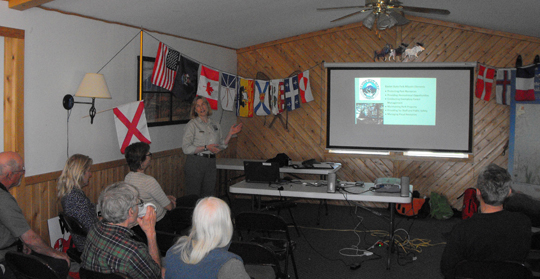
The crowd swelled on Saturday morning to hear a full program of presentations, including an update of activities and work in Baxter State Park by Park Naturalist Jean Hoekwater. An effort to re-route the Abol Trail from the bottom of the slide to safer ground to the west and north will require an additional trail crew, and will be funded in part through a special contribution made by a long-time friend of the park. Susan Adams of Katahdin Woods & Waters and Karin Tilberg of the Forest Society of Maine also provided updates of their work. As the impact of mill closures and declining populations is felt in the Millinocket and Greenville areas, both communities are exploring the role that the forests, rivers and trails can play in the future. In their own ways, Katahdin Woods & Waters and the Forest Society of Maine are proving to be great partners.
IAT Maine board members, Walter Anderson, Bob Marvinney, and Earl Raymond presented new and pending activities in the session before lunch. Walter previewed “Pioneers in Appalachian/Caledonide Geology”, a web-based initiative to honor leaders in geology who have contributed to our understanding of the range of ancient mountains at the heart of the AT and IAT. Walter has chaired the international committee that identified and vetted the geologists to be honored posthumously. The Pioneers website will be launched at the ATC Conference in Winchester, Virginia, in July. Bob and Earl provided overviews of two small mountains that we hope will be linked more directly to the IAT in Maine – Sugarloaf, southwest of Shin Pond and Mt. Chase to the northeast. Sugarloaf can be reached by way of a network of gravel roads. A potential shorter route for a footpath will be explored in the coming months. Earl presented a map of a potential trail route over Mt. Chase from the Ackley Pond Road to Hall’s Corner, and everyone in attendance agreed with the goal of eventually routing the IAT over the summit of Mt. Chase.
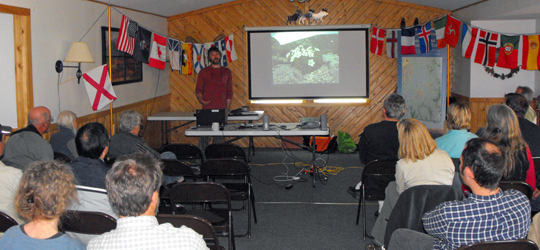
Botanist Glen Mittelhauser presented the Flora of Baxter State Park project after lunch, including a highlight of the array of the Ericaceae—the blueberry family—found in the park. Dozens of volunteers have helped over the five-year life of the project locating and identifying the hundreds of species of vascular plants to be included in the Flora. Thousands of photographs and a detailed GIS-based database were assembled during the life of the project, providing a significant baseline resource for Park managers. As the climate changes in the coming decades, Baxter Park will be a in a good position to measure impacts against this robust database of information provided by Glen and volunteers.
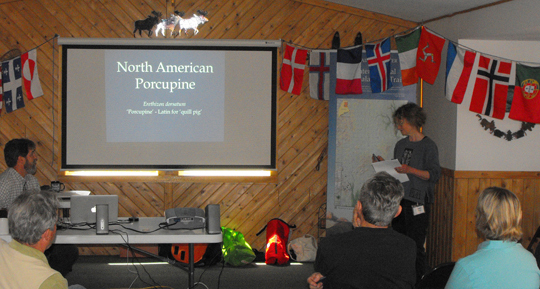
From plants to porcupines, IAT Maine member Jude Eldridge provided a glimpse of the natural history of the porcupine, with the assistance of ‘Bob’, a quirky, possibly injured porcupine that frequented her yard in southern New Hampshire a couple of years ago. We have a number of lean-tos and outhouses along the trail in Maine, and more than one has become a winter home to denning porcupines. Though we may not like the damage that a porcupine can do to a building or structure, we have a new appreciation for the ungainly rodent thanks to Jude’s comprehensive account. Old myths debunked; a fresh appreciation for one of the odd animals in our forests gained.
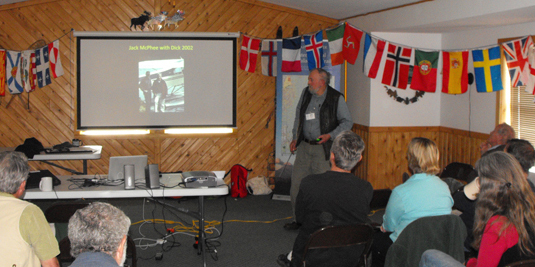
IAT board member Will Richard published a major work on the land and the people between Maine and Greenland—Maine to Greenland: Exploring the Maritime Far Northeast—in September 2014, and he provided us with a great summary of the travels and expeditions that informed the book. The IAT earned a chapter in the book, with highlights of the first walk by John Brinda, and subsequent treks by Eb Eberhart—Nimblewill Nomad. From Crow Head to Ellesmere, Uummannaq to the Eastern Settlements, and along the Lower North Shore of Quebec and Labrador, Will and his co-author William Fitzhugh of the Arctic Studies Center of the Smithsonian, have made a great contribution to our understanding of the human history of our corner of the planet.

The afternoon session wrapped up with a brief glimpse of the new Trail Guide for the IAT in Maine currently being assembled by Bill Duffy and Herb Hartman. The new guide builds on the first one written for the East Branch section of the trail, and extends the coverage to the border at Fort Fairfield. The guide is on schedule to be available in June.
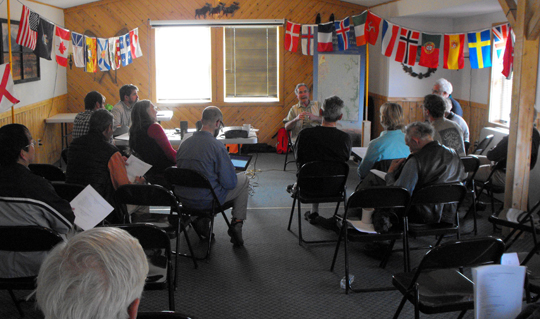
The official Annual meeting of IAT Maine was held at 4 PM on Friday. The nominating Committee submitted a slate of names for Board members for the coming year. All existing Board members were reelected to the Board with the exception of Thomas Urquhart who chose to retire from the Board, after many years of service. Josh Bowe from Standish was a newly elected Board member.
The existing officers were reelected for another one year term. They are as follows: Don Hudson – President, Cheryl St Peter – Vice President, Dick Anderson – Tresurer and Seth Levy – Secretary.
The formal program concluded after dinner with a succinct presentation on the new tool for geologists and planners, LIDAR—Light detection and ranging. LIDAR employs a complex array of lasers to penetrate forests and ground cover to reveal the contours of the earth at intervals of 2’ or less. Maine State Geologist Bob Marvinney provided a clear explanation of the technology, and then presented a series of examples to illustrate the power of LIDAR to reveal important features that might otherwise evade detection. With the help of LIDAR, geologists, archaeologists, land use planners, and others can gain a much better understanding of the underlying landscape, bedrock, and surficial features that might impinge on some potential land use. The coast of Maine has been surveyed completely with this new tool, in anticipation of the impact that sea level rise might have on roads and other infrastructure. A large block of central Maine is currently on the docket for surveying, if sufficient funds can be raised.
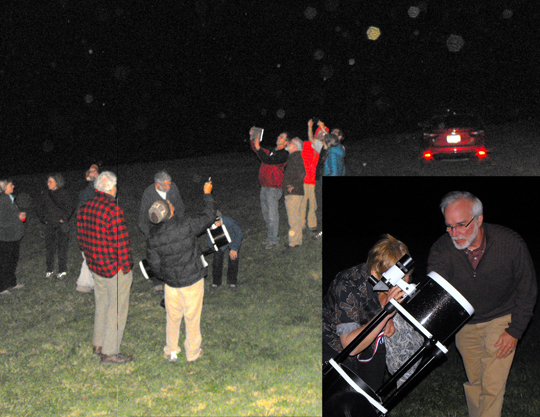
IAT Maine runs through one of the darkest night sky regions of the United States, and on both Thursday and Friday nights, Bob Marvinney, Earl Raymond, and Nancy Hathaway provided the night owls with a glimpse of the planets and stars of our Milky Way. A special thanks to Terry and Craig of Shin Pond Village, who switched off a number of street lights and other outside lights for an even clearer viewing of the night sky.
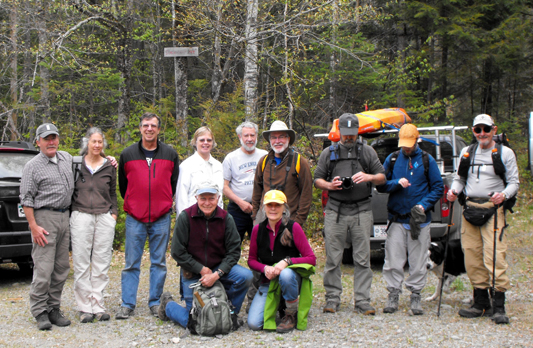
The 21st annual meeting wrapped up on Saturday morning with a hike up Sugarloaf, including a stop at the famous fossil locality described by USGS Geologist Bob Neuman in 1963. The fossil brachiods—ancient shellfish—found there are identical to ones in Wales and Ireland. Bob Neuman’s descriptions provided important evidence and defense for the young theory of plate tectonics and continental drift, which now we take entirely for granted. The geologic story of the closing of the Iapetus Ocean at the formation of the super continent Pangea is the story of the IAT, so a visit to this little mountain is something of a pilgrimage. With luck, in future years, there may be a second, shorter route to the mountain from the IAT along Rt. 159.
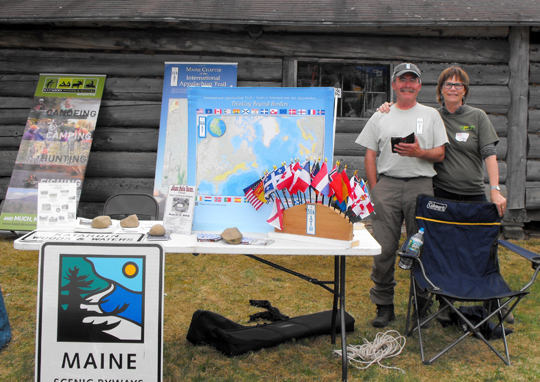
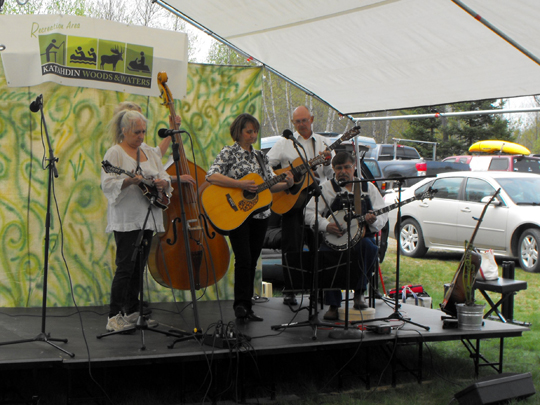
On Saturday afternoon IAT members, Walter Anderson, Phine Ewing and Don Hudson tended a booth at the 2nd Fiddlers & Fiddlehead Fest, held this year at the Lumberman’s Museum in Patten. This year’s Fest featured dozens of musicians from Quebec, New Brunswick and Maine, a special fiddlehead fern cook off, and a full array of local organizations, artists, and craftsmen. An official head count was not available, yet over 400 people enjoyed the afternoon.
Hope you can join us next year!
